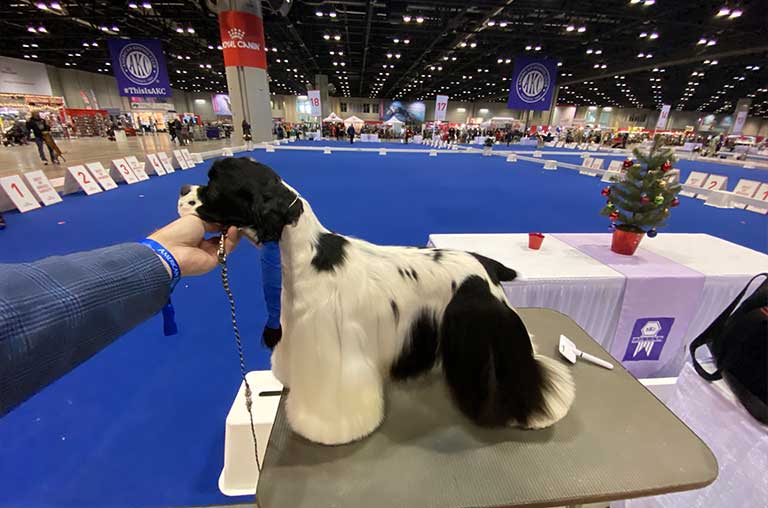If you have ever noticed some of the Cockers with docked tails or Spaniels without tails you must have thought why dock a cocker spaniel tail? The partial or complete reduction of a dog’s tail for aesthetic purposes or to ward off potential harm is known as tail docking. Cutting or crushing muscles, nerves, and bones without anesthetic in puppies under five days old constitutes an antiquated practice.
This is a year-old custom that dates back to the Roman Empire. Cutting off all or part of a dog’s tail is known as docking, but why do people do it? We’ll dig into the practices, and justifications of tail docking. Specifically, we will be explaining why to dock a cocker spaniel tail. This article covers all the essential information about cocker spaniels, tail docking, and why it might soon become obsolete.
Is tail docking harmful to Cocker Spaniels?
Almost 40 countries around the world have banned docking. Concerns and debates arise regarding the morality of dog tail docking. Most animal activists applaud this action as a positive beginning toward shifting public perceptions of breeding practices and tail docking. Although tail docking is permitted in the United States, the American Veterinary Association has adamantly opposed it because of the potential for consequences.
Infection, tumors, cerebrospinal fluid leakage, and even death are among the potential side effects of tail docking. Additionally, cocker spaniel puppy tail docking can be extremely painful for a young puppy. There is a lot of evidence to the contrary, despite some experts’ claims that neonatal puppies’ neural systems are not fully developed and therefore cannot feel the discomfort of tail docking.
Does Docking Hurts Cocker Puppies
The people who performed docking claim that because of the underdeveloped nervous system of puppies, they don’t feel discomfort. Different evidence suggested that puppies and adult dogs have the same threshold of suffering from pain. The docking happened without using anesthesia making it even harder for puppies to suffer through a lot of pain. A puppy’s tail can be docked by destroying connections between bone and cartilage, muscles, tendons, and a maximum of seven pairs of extremely sensitive nerves.

When the tail is cut off and while the wound is being stitched, puppies repeatedly make severe screeching voices, showing that they are in great discomfort. While the incision heals, inflammation and tissue damage also contribute to persistent pain. Additionally, this unneeded procedure carries a risk of infection or other issues.
Risks That Are Linked To Dogs Tail Docking
Mobility Issues
The tail of a dog is made up of vertebrae and other crucial tissues to maintain the animal’s equilibrium, serving as a continuation of the spine.
A dog requires its tail, which serves as the “helm of the ship,” when running, turning, and performing specific movements.
Since most animal species that need speed and agility have tails, it may have acted as an evolutionary benefit.
Another argument against tail-cutting in dogs is connected to these post-operative locomotor issues, a dog’s temperament, and neurobiological factors that are adversely affected, aside from the physiological discomfort experienced during the treatment.
Difficulties with socializing
Studies have shown that dogs without tails are in great danger of behavioral issues. A compensatory issue that often leads them to be misunderstood by other dogs. All these bring a great disadvantage for Cockers that has no tail or docked tail. A longer tail is more effective in communicating intraspecific information than a short tail. However, you can deal with this issue by socializing your Cocker Spaniel puppy at an early age.
Another problem with docked tails in dogs is docking made them look weird which leads kids to be easily frightened by them. You cannot imagine your favorite doggo not wagging their tail while looking at you or when they are happy.
The Post-Operative Health Issues
There are just a few pieces of research showing the health and well-being of docked and uncloaked dogs that discusses the long- or short-term effects of the surgery. After a dog went through a tail docking some common issues have been found in them. There is a chance for excessive bleeding, infection, slow recovery, and even necrosis. The occurrence and persistence of neuromas, which have been linked to persistent discomfort, are unknown.
Chronic Health Problems

It has been hypothesized that dogs with docked tails may have undeveloped pelvic musculature, although the evidence isn’t clear-cut. Incontinence is more common in dogs of docked breeds, but this could be related to characteristics other than docking. It’s also possible that other features like docked tails are to blame for the higher occurrence of incontinence in dogs of docked breeds.
Other Concerns
The value that certain societies place on tail docking could have an indirect impact on animal welfare if it encourages less qualified individuals to undertake the surgery when a veterinarian declines to do it or if a dog without a docked tail has a harder time finding a good home.
The Reason Why Dock a Cocker Spaniel Tail
One of the main reasons is to keep the breed standard. While some pet parents often prefer docking their long-haired dog’s tail to keep them safe from fecal matter. To keep up with AKC requirements, purebred dog breeders frequently undergo these surgical changes. For more than 60 breeds—nearly a third of those listed on the registry—tail docking is the AKC standard. Animal rights activists emphasize that because the AKC won’t create an exception for undocked dogs to compete in shows, the breed rules actually support this antiquated practice.
working cocker spaniel with docked tail
It has likewise been stated that adult dogs who sustain accidental tail injuries endure more pain than puppies who have their tails amputated. Once there was a thing that people would love their service dog to be docked. But, nowadays, most dogs are not worked, they are companions.
However, docking continued as people kept working dogs as both pets and for shows. Though its original function was no longer important, the reduced tail eventually had become a part of the “breed standard.” Numerous puppies had their tails docked, often without good reason, even though they would never be trained and were not likely to harm their tails.
This has led to a growing amount of public opinion against docking and put pressure on the government to ban the practice.
How To Take Care Of Your Docked Cocker Spaniel

A vet should do the procedure because it is illegal to dock a dog’s tail in the UK unless there are special circumstances, such as with working cocker spaniels. In the US, there are no explicit docking regulations. Cocker spaniels are well known for having a tail that never stops wagging.
Additionally, it is advised to take your Cocker to a professional groomer a few times a year. Personally, I think Cockers look better than those with docked tails. The docked Cocker Spaniels will need more attention and care to keep things healthy and secure from any danger compared to those who haven’t had their tails docked.
How commonly undocked cocker spaniel tails be seen?
Cocker spaniels with full tails are common. Cocker Spaniel with full tail isn’t rare, in fact, most of them are born with full-length tail just like any other dog. Naturally, a Cocker spaniel with tail has a fluffy tail. Their tails are typically docked in order to comply to breed standards established by kennel clubs like the American Kennel Club. The cocker spaniel tail not docked is becoming more prevalent as tail docking bans continue to be enforced by legislation.
Reason Why You Shouldn’t Dock Cockers Tail
- We have covered the significant disadvantage of having a docked tail, which is communication, aside from the discomfort and suffering it could cause.
- The movement of the tail can convey a lot of information to other dogs. Dogs can give off cues about their friendliness or unfriendliness, respectively.
- The ability to communicate like “hey, I’m nice!” to other dogs is nearly entirely eliminated by having one’s tail docked. An approaching dog will not be able to perceive a 2-inch stump that is waving.
- The risk of tail trauma in dog breeds with traditionally docked tails has not been shown to be sufficiently high to support the practice.
Unexpectedly, the cocker spaniel tail problems develop frequently. Canines with docked tails have a tougher time getting along with other dogs as a result. Knowing all these disadvantages people should start asking “Why Dock a Cocker Spaniel Tail” and stops the practice as soon as possible.
The bobtail cocker spaniels, what about them?

A cocker spaniel’s likelihood of being born with a bobtail, or naturally short tail is also a scenario we get to be seen. A significant gene mutation causes recessive traits and is responsible for this. Bobtails can be inherited from any bloodline and are present in all breeds. They resemble docked tails very much.
It is never a good idea to breed bobtail cocker spaniels with other bobtails because the results can be disastrous for the dogs’ health. If you plan to breed your spaniel, it is compulsory to confirm the docked tail was from surgery. Breeders typically inform owners if a dog has a bobtail, but it could be challenging to determine for a rescued dog.
FAQ’s
1. Should You Dock a Cocker Spaniel’s Tail?
Only veterinarians have the authority to determine if a dog’s tail should be docked. To be clipped, the dog must fit a specific type requirement. As follows: Welsh and English Cocker Spaniels are breeds of dogs, Cockers but not any breed-breed combinations.
2. Is It Cruel to Dock a Dog’s Tail?
Definitely, it is cruel, dogs communicate with their tail. Dogs utilize their tails to balance. This process of cutting a dog’s tail hampers its communication with other dogs which makes them misunderstood by others.
3. Why Do Working Cockers Have Their Tails Docked?
Any type of spaniel, terrier, hunt point retriever or their hybrids may be docked in England (as long as the necessary evidence indicating that they are likely to work is produced). If owners or guardians want to have a service dog’s tail docked, they must make sure that it is done legally.
4. Why Do They Cut Off Spaniel’s Tails?
The first reason for docking is to stop the dog from being hurt while it’s working. There is another common reason among breeders to dock spaniels’ tails was to match the breed standard in preparation for dog shows.
5. What is the Purpose of Docking a Dog’s Tail?
The initial intent of the tail dock was to protect the end of worker pups’ tails from harm. Hunting dog owners learned that adult dogs were less prone to hurt their tails while working if the tail’s tip was cut off right after birth.
Final Thoughts
People are asking if there are tails on cocker spaniels. They do have them, in fact, from birth cocker spaniel tail length exists just as other normal dogs!
It makes sense that people would have this issue as many spaniels have had their tails shortened in order to fit breed standards. Others have had their tails docked to prevent harm while working or hunting. Cocker spaniels do have tails, and after reading through all the points above on “Why Dock a Cocker Spaniel Tail” it is up to you whether you think docking is a good idea or not.

I live in a tropical country, and my pup always gets caught up in the bush with prickles etc on her tail. In France they are reversing the law regarding docking of tails.
Mam cocker spanielkę i ma śliczny długi ogon.Cały czas nim macha.Widac że szczęśliwa. Nie jestem ani za obcinaniem ogona,ani uszu ani nawet wycięciu jajników (sterylizacja).Moja sunia ma cieczkę i nie jest to żadnym problemem.Ma swoją bieliznę i pampersy . Uważam że obcinanie jakiejkolwiek części ciała jest tylko i wyłącznie fanaberią i wymysłem człowieka, żeby było nam wygodniej.Jest to jednak sprzeczne z zasadami natury.Po coś ten ogon,uszy i narządy rozrodcze są skoro pies się taki urodził taki powinien zostać i tą samą zasadę mam w stosunku do ludzi. Żadne operacjeplastyczne,czy tatuaże i piercingi nie zastąpią nam urody jaką nas Pan Bóg stworzył. Naturą wie co robi.Nie powinniśmy niczego usuwać i przerabiać. Ani u zwierząt ani u ludzi. Głupotą jest krzywdzenie siebie i innych tylko i wyłącznie dla naszych widzimisi